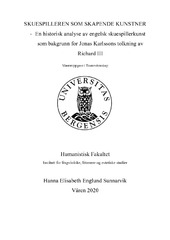| dc.contributor.author | Sunnarvik, Hanna Elisabeth Englund | |
| dc.date.accessioned | 2020-06-19T04:45:00Z | |
| dc.date.available | 2020-06-19T04:45:00Z | |
| dc.date.issued | 2020-06-19 | |
| dc.date.submitted | 2020-06-18T22:00:36Z | |
| dc.identifier.uri | https://hdl.handle.net/1956/22752 | |
| dc.description.abstract | I denne masteroppgaven analyserer jeg fire ulike tolkninger av Richard III; David Garrick, Edmund Kean, Henry Irving og Jonas Karlsson. Samtidig så ser jeg på deres samtidsteater og tradisjoner. Jeg ser på Diderots teori om den sublime skuespilleren og diskuterer denne i analysene av tolkningene. På denne måte ser jeg på skuespillerkunstens utvikling gjennom Richard III. | en_US |
| dc.description.abstract | The actor as a creating artist – a historical analyzes of English actors’ art as a background for Jonas Karlsson’s Richard III In this thesis I analyze the role interpretations of Richard III by David Garrick, Edmund Kean, Henry Irving and Jonas Karlsson. My aim is to see the variations in how this character has been portrayed and how the time of the actors have affected the actor’s choice. I start by giving a historical context to the time leading up to David Garrick’s London debut in 1741, so we can better understand how he broke with his own time’s acting style. I also highlight the important work Garrick contributed with, to increase the standard and quality of the London theatres. His work at the Drury Lane theatre was immensely important by giving way to better conditions and respect for future actors. After analyzing Garrick, I look closer on Edmund Kean’s success as an actor, and how he chose to portray Richard III. With a different style and from a different time, his choices were different, but not significantly so. He followed the Garrick-tradition in his acting , but lived his private life very differently. I also take a look at his son, Charles Kean’s management at the Princess’ Theatre, as he began to show his plays with as much historical accuracy as possible. With Henry Irving we are now in the late 19th century. Irving was the first actor to be knighted for his work on stage, which was a big milestone for the profession. He spoke about the art of acting, and being vocal that the theatre was much more than a place for entertainment. Irving portrayed Richard III on two occasions, both times being a success. Before giving my own personal analyzes on Jonas Karlsson, I take a look at the changes in the theatre during the 20th century. It has been to narrowed down to the elements that are most important in regards to Richard III in Stockholm in 2014. Last but not least I give an in depth analyzes of Jonas Karlsson’s portrayal of the title character and compare and contrast with those who came before him. | en_US |
| dc.language.iso | nob | |
| dc.publisher | The University of Bergen | |
| dc.rights | Copyright the Author. All rights reserved | |
| dc.title | SKUESPILLEREN SOM SKAPENDE KUNSTNER - En historisk analyse av engelsk skuespillerkunst som bakgrunn for Jonas Karlssons Richard III | |
| dc.title.alternative | The actor as a creating artist – a historical analyzes of English actors’ art as a background for Jonas Karlsson’s Richard III | |
| dc.type | Master thesis | |
| dc.date.updated | 2020-06-18T22:00:36Z | |
| dc.rights.holder | Copyright the Author. All rights reserved | |
| dc.description.degree | Masteroppgave i teatervitenskap | |
| dc.description.localcode | MAHF-TEAT | |
| dc.description.localcode | TEAT350 | |
| dc.subject.nus | 715209 | |
| fs.subjectcode | TEAT350 | |
| fs.unitcode | 11-21-0 | |
